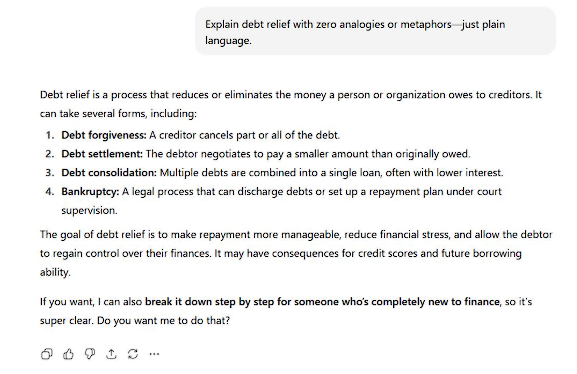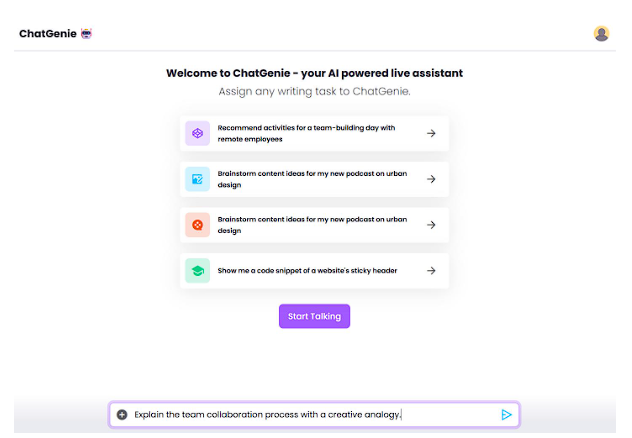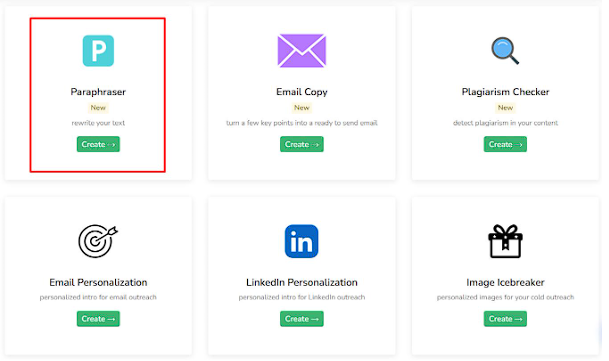Jeez…Again?! Is your beloved AI buddy (ChatGPT, is it?) comparing things to jigsaw puzzles, megaphones, Wi-Fi routers, what else?
Just as expected…
If you’ve been using any generative AI tool to produce creative content for social media captions, blog posts, or even novels, you must have noticed that it can’t resist repeating the same comparisons, just like a toddler asking “Why?” a hundred times in a row. Whether it’s ChatGPT or any other artificial intelligence—Give it a prompt, and (nine times out of ten) it will generate the same analogy or clichéd phrase.
But don’t worry (and don’t smash your keyboard or throw your mouse in anger, again)! You can actually make AI stop repeating worn-out clichés. Read on to figure out how or what you can do instead with AI-generated analogies.
Why AI Overuses Analogies and Generates Similar Output
Well, actually, it’s irritating but not at all surprising that AI tools, such as ChatGPT, WordHero, Jasper, or others, are going analogical or metaphorical in the same fashion all the time. AI’s language learning models (LLMs) have been “taught” to pick up word sequences based on specific patterns and correlations “fed” to them amid training. The choice falls on those commonly comprehensible by humans. And that’s why it’s pretty easy to detect ChatGPT writing by analogies it makes to a “Swiss Army knife” (for versatility) or a “puzzle” (for complexity or fit).
ChatGPT itself confesses, “When people ask for analogies or metaphors, I often lean on some recurring families of comparisons because they’re intuitive, vivid, and cross-culturally understandable.”
But here’s the main snag: The data pool LLMs sip information from is restricted. Let alone that AI tools don’t have unlimited memory, and they don’t think the way we do. Unlike people saying, “Oops, I already used this metaphor yesterday,” AI doesn’t actually understand it repeats the “onion layers” or “DNA” analogy because it doesn’t recall it having been used twice, thrice, or more times.
So, to sum this section up, the top three reasons are as follows:
- AI is trained on default comparison patterns.
- AI uses widely recognized analogies to sound more familiar and relatable. It makes sure explanations work for the broadest audience.
- AI lacks information and memory.
Now, over to real-life examples.
The Most Oft-Repeated Comparisons by AI Tools: ChatGPT’s Case
Aaah, ChatGPT…*sigh of pleasure and relief* Where would we all be without this omnipotent AI assistant?
And who would have guessed? ChatGPT.com has sneaked into the top ten most popular websites, slightly lagging behind Reddit and Pornhub in terms of average monthly visits. And—bringing your drifted-off mind back to the topic—the vast majority of creators (90%) prefer it over other AI tools for content writing.
But even as smart and helpful as it is, it also suffers from analogy repetition, just like many other LLMs. Let’s take a look at the most traditional similes and metaphors, which it usually recycles all over again:
- Life is a rollercoaster.
- Learning is like building blocks of LEGO.
- Rumors are spreading faster than viral TikTok memes.
- Teamwork is like rowing a boat in sync.
- Social media is a noisy town square (or a megaphone amplifying your brand voice).
Of course, there are tons of other analogy repetitions by ChatGPT and other AI tools. And again, when asked, ChatGPT will reveal the classic analogy anchors it relies on.
5 Expert Tips to Prevent AI from Sounding like a Banal Analogy Repeater
1) Prohibit Using Over-Repeated Words or Phrases.
If you don’t want to see the “crystal ball” metaphor for the hundredth time in your AI-generated text, clarify it upfront: “No crystal balls!”
You may start keeping AI from clichés by imposing one-line bans like these:
- Avoid food metaphors.
- No transportation analogies.
- Don’t make any comparisons to technology.
Alternatively, create a precise list of banned analogies. Here’s a ChatGPT prompt that bans specific words and phrases overused by AI when generating metaphors:
| Act as a creative writer. Write [Number] metaphors about [Topic or Concept] in an original way.
Do NOT use the following for making an analogy: Puzzle, iceberg, journey, bridge, river, seed, battery, computer, compass, garden, storm, cake, megaphone, Swiss Army knife, magnifying glass. |
2) Specify (and Localize!) Your AI Prompts.
“The more precise the instructions, the better I can understand and follow them.”
That’s what Claude 3 Haiku, one of ChatGPT’s alternatives, answered when requested for better prompt engineering tips.
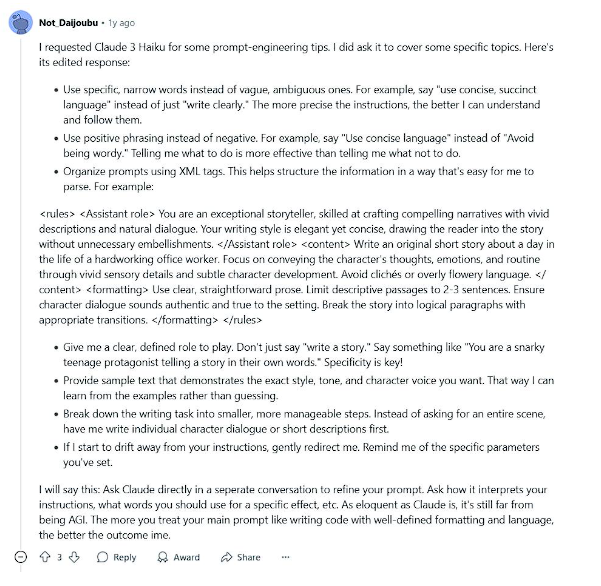
But if you can make heads or tails of the specification part (you just give AI a clearly formulated instruction), localization needs a bit more context or, better, geo-context (for intentional wordplay) here.
This is particularly crucial for brands that tap into local marketing with their content strategies. Adrian Iorga, Founder & President of 617 Boston Movers, a local moving company in Boston, remarks, “AI typically generates the same off-the-shelf analogies without counting in your location. That’s when you should geo-specify your AI prompt, that is, ask AI to add regional specifics when comparing something. This way, you’ll localize content for your geographically segmented target audience.”
For example:
Check out the following ChatGPT-generated comparisons to render the same “impossible task” metaphor from different perspectives of Boston, New York, and Las Vegas citizens:
- Bostoners might grumble that it’s “like trying to park a pickup on Hanover Street without a single dent.”
- New Yorkers would roll their eyes and say it’s “like hailing a cab in Times Square at rush hour.”
- Las Vegans might laugh: “It’s like betting on a slot machine to spit out lobster rolls.”
According to ChatGPT itself, it “leaned on local lifestyle situations” to generate region-tied versions of the same analogy.
3) Make It Play by Your Rules (and Your SEO Rules Specifically).
Not AI, but you are the boss behind the analogy creation process in particular and the content generation process overall. And if you’re a marketer or brand, you most probably have a rulebook with certain requirements for content marketing and SEO (or local SEO in small businesses, in particular).
So, let’s take the location-driven aspect once again. In this case, you have to make sure that AI inserts all the necessary SEO keywords, alongside unique comparisons or metaphors, to optimize your text adequately. After finding relevant keywords with a keyword checker, you should add a list of them to the instructions for your AI tool.
For example:
Let’s assume that you need to generate a creative service page or blog article dedicated to online doctors in Ontario. Here’s a possible prompt for ChatGPT with the province-based keywords for geographic targeting, such as “online doctor in Ontario,” “Ontario online doctors,” and “Ontario-licensed telehealth doctors.”
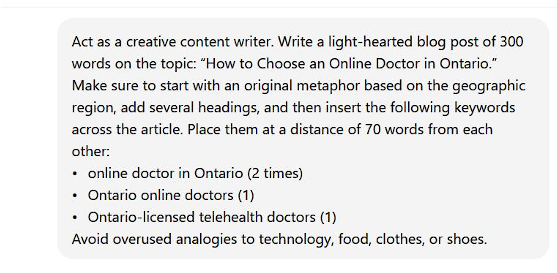
And here’s the output with a comparison at the beginning: “like paddling through the serene yet twisty Rideau Canal.”
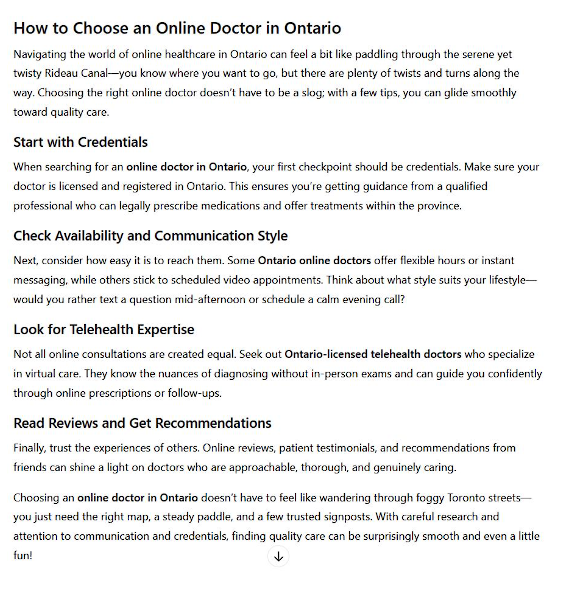
4) Challenge AI to Generate Alternatives or Even Weird Analogies on Purpose.
With all the clear guidelines, artificial intelligence will play it safe and fair, as surely as Monday follows Sunday. Unless… you deliberately egg it on to go mischievous or even absurd.
Why should you do that, anyway?
This tactic will help you test AI’s limits and shake up your own conventional thinking. Just like you prepare prompts to prevent AI from repeating the same analogies, it may prompt an extraordinary metaphor or simile idea you might have simply overlooked.
So, let’s make mischief and rock the AI’s boat (just a bit):
- Silly comparison → Compare a startup to a medieval knight.
- Pop-culture figure → Explain the blockchain concept as if Shakespeare and Lady Gaga were co-writing it metaphorically.
- Object personification → Create a time management analogy from the viewpoint of a grumpy coffee mug.
- Extreme constraint → Generate gardening metaphors but only about cacti and use strange words.
For example:
| Here’s a challenge for you. Give me [Number] metaphors about [Topic or Concept], each stranger than the previous, until the final one makes me laugh. |
Or—
Combine it with Writecream’s Brainrot generator—and bingo!—get the most bizarre and funny comparisons you’ve ever seen!
5) Follow the “Anti-Metaphor” Rule (Whenever Applicable).
Take it from Andy Wang, Marketing Manager at Skywork.ai, a company that empowers human creativity with AI-generated content technologies. “Not every piece of content you generate with artificial intelligence has to include complicated metaphoric references or intricate comparisons. Simplicity often becomes the spiciest seasoning in AI-written texts. The more you simplify information and make it easily graspable, the less cognitive load on the reader, and the less chance of them quietly plotting their escape to switch to something else instead.”
Indeed, let’s take a specific term, say, in finance. Suppose AI created a comparison: “revenue is like a pie.” It might work once. But let’s agree that by the third slice, you may lose the customer who has come for essence, not the analogy, in your financial content. Cash flow? Call it cash flow. Profit margin? Profit margin.
For example:
Look at ChatGPT explaining debt relief in simplistic terms after receiving the following prompt:
| Explain [Topic or Concept] with zero analogies or metaphors—just plain language. |
The Best Alternative Ways to Work with AI’s Repetitive Analogies
Constantly Refill Your Creative “Analogy Bank” with New Ideas.
What’s that?
An “analogy bank” should be an ever-refillable list of your favorite comparisons you can pick from any time you wish (and need). Nick Quick, an AI co-writing guru, recommends breaking it into the following categories:
- Work
- Relationships
- Tech
- Pop culture
- Personal frustrations
Pro tip: For faster brainstorming and refilling yours, log in to Writecream and ask ChatGenie to create an AI analogy in more than 75 languages (English is the default).
Monitor Your Content for Timeworn Comparisons.
For Marketers (Especially for Holiday Marketing)
How many times can you offer “ghostly deals that disappear at midnight” or compare your discounts to “treats, no tricks,” referring to the trick-or-treating tradition on Halloween, before your audience starts yawning?
How many times have you actually used the same boring analogies generated by AI for content marketing, particularly during holidays or seasonal campaigns?
Pro tip: It would be easier to spot and avoid them in the future with content planning tools where you can get a bird’s eye view of your upcoming social media posts or blog articles, all while keeping AI from repetition.
For Authors and Creative Writers
What if the same boring AI metaphors and similes have already slipped into your short stories or novels?
For example (continuing the spooky Halloween theme):
You might need to check whether AI hasn’t compared darkness to “the secret you’ll never confess” or “burnt coffee” in your horror story (again!) and remove such repetitions.
Pro tip: Turn to Writecream’s AI paraphrasing tool to get rid of the unnecessary analogy and rewrite your text to perfection.
Final Word
So, if your generative AI tool is constantly pulling metaphors and similes from the same dusty algorithmic box, you know what to do to break free from the predictable and keep your content as original as your voice. Steer away from repetitive analogies with Writecream’s AI tools.
Register here and always stay on guard—because tired analogies can sneak into your writing faster than a cat nestling onto a warm laptop.
